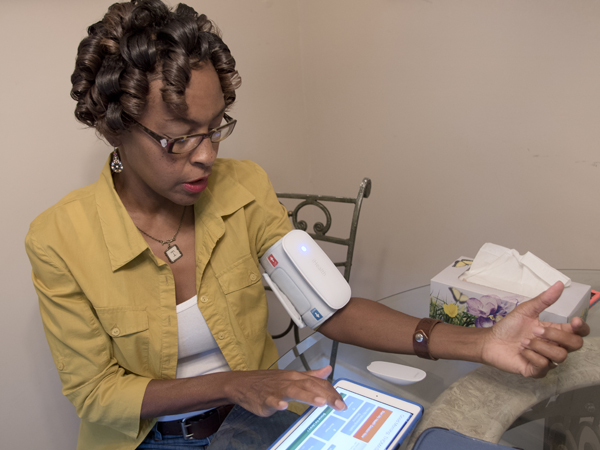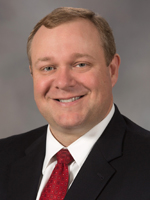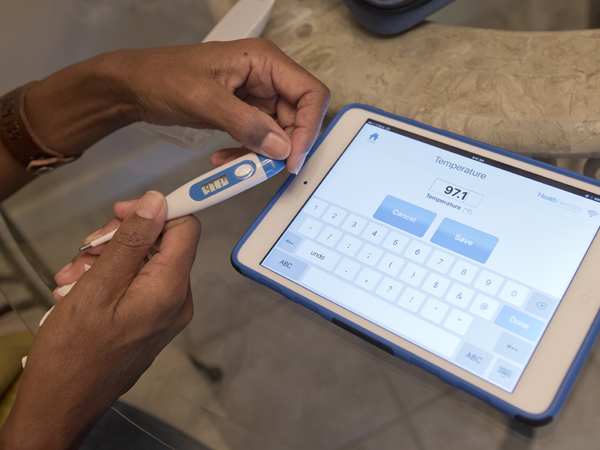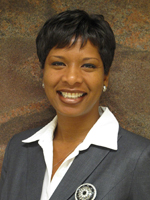UMMC telehealth enters next chapter of remote patient monitoring

As the University of Mississippi Medical Center's heralded pilot program to remotely monitor Delta diabetes patients wraps up, lessons learned already have improved care for hundreds enrolled in UMMC's telehealth network.
The same model used to bring care to patients in the Diabetes Telehealth Network is now being deployed -- with significant technology upgrades -- for patients coping with chronic obstructive pulmonary disease, hypertension, kidney disease and a number of other conditions that require chronic disease management. That's in addition to adult and pediatric diabetes.
“A lot of our patients hadn't touched technology before the Diabetes Telehealth Network. Many didn't have Internet,” said Michael Adcock, administrator of the Center for Telehealth at UMMC. “But once they found out how easy it was and how useful the information is, they embraced it.
“It's been extraordinarily beneficial from the point that it makes them feel more comfortable with their health-care team. They've appreciated getting education about their health in bite-sized pieces. Over time, that gives them a good knowledge of their disease.”

The Center for Telehealth was created in 2003 to meet the dire need for specialized care and other public health services for Mississippi's rural corners. Its Diabetes Telehealth Network, a partnership between UMMC, Care Innovations, C Spire, GE Healthcare, the office of Gov. Phil Bryant and North Sunflower Medical Center, kicked off in early 2014 in about 20 Delta counties. The program allowed doctors and other health practitioners to treat patients remotely, in real time and at home, using online streaming video technology and other tools for two-way live communication. Participants were trained on tablet computers loaned at no cost and requiring a cellular broadband connection.
It abundantly met its goals of improving clinical outcomes and care coordination for managing diabetes, increasing access to care and conveniently bringing health-care resources into patients' homes, Adcock said. The benefits were verified through initial data on the first 100 patients in the pilot - results so encouraging that there was no need to wait for final data to expand remote patient monitoring to those coping with other chronic illnesses, he said.
“What we've learned has prompted us to change the technology a bit. We now use an iPad Mini instead of a larger tablet,” Adcock said. “And, we're using Bluetooth so that they don't have to plug anything into their device.”
That's the case with Jackson resident Thomasene Bennett, who in July had a kidney-pancreas transplant at UMMC. She's quickly adapted to a twice-daily routine of using her iPad Mini to transmit information to her Medical Center caregivers so that they can more closely monitor her recovery. “It's very convenient,” she said.

“I get up around 7 and check my vital signs. I turn on the tablet, and it says, 'Good morning, Thomasene,'” said Bennett, 46. “I check my vital signs and then push a button, and it tells me my blood pressure, sugar and temperature. I push another button, and it automatically goes into the system to save the information.
In Mississippi, residents in 53 of 82 counties must drive more than 40 minutes to see specialists. The center has recorded more than 500,000 patient encounters since 2003 and today has 218 service locations with a menu of 35 medical specialties for both adults and children. It's delivered to local clinics, rural hospitals and for chronic disease management, to patients' homes.
“Most companies do a piece of telehealth - for example, urgent care activities. They don't provide the comprehensive services around chronic disease,” Adcock said. “The complexity of our services sets us apart from other telehealth providers.”
The specialty care includes Telemergency, which places nurse practitioners in the emergency rooms of 15 rural hospitals throughout the state in addition to UMMC's campuses in Holmes County and Grenada. Emergency room staff connects via live video to emergency medicine physicians in UMMC's Emergency Department.
Services being replicated from the Diabetes Telehealth Network model include scheduled live video health sessions and coaching on diet, exercise and adherence to medications. Diabetes Telehealth Network patients also took and reported their own vital signs. If they failed to check in each day or their vitals weren't in a healthy range, a health practitioner would contact them.

After she records her vitals, Bennett said, a Center for Telehealth registered nurse calls her. “If she sees something suspicious, she'll ask me to take it again and resend. If it's not better, she will tell me what I need to do. It's working wonderfully. I love it.”
Adcock said preliminary data from the diabetes patients shows a remarkable 96 percent took their medications as directed and 83 percent kept their scheduled telehealth appointments. The data also showed that the patients' average hemoglobin A1c level dropped, bringing them closer to the normal range for those without diabetes, Adcock said.
Not one patient was hospitalized or visited an emergency room because of complications from diabetes. And, providers found nine cases of diabetic retinopathy that might otherwise have gone undiagnosed. Many avoided sugary desserts because they knew their telehealth caregiver would pick up on it through their vital signs. Patients overall also stayed off the roads more than 9,000 miles rather than driving to Jackson specialists or those across state lines.
“We're addressing health disparities that have to be addressed. Our team is dedicated to helping health-care organizations deliver better care and access to more patients at a lower cost,” Adcock said.

Tonya Moore, the center's administrator for community health services, often travels to the state's most rural communities to integrate patient monitoring technology for patients and local providers.
“The doctor will need to be educated on the criteria and the process so that when a patient comes to them with a chronic condition that we can support with remote patient monitoring, the physician will make a referral back to the Center for Telehealth, The doctor can tell the patient, 'I have a solution for you in partnership with UMMC.'
The patient can take their iPad Mini to their doctor and show them their results, Moore said. And, providers can electronically connect to UMMC's health records to see that information. “What's important to us is closing the communication loop to the provider,” Moore said.
“If my doctor wants to look at my history, all he has to do is push a button and it all comes up,” Bennett said.
Paving the way for enhanced use of the diabetes telehealth model was passage of a law by the 2014 Mississippi Legislature that requires insurance companies and Medicaid to reimburse for both remote patient monitoring and store-and-forward telemedicine.
“The idea is to empower patients,” Moore said. “We want to put a device in their hands to allow them to better manage their own chronic disease, and we want to support the doctor or nurse practitioner who takes care of them so that they can spend more time with their patients.”


